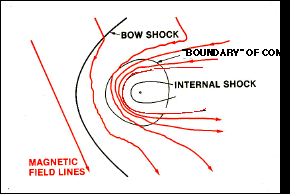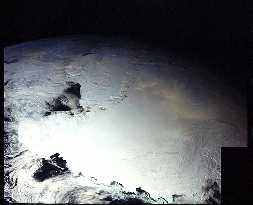This is an image of Antarctica, giving an idea of what an icy surface might look like from space.
Click on image for full size
JPL/NASA
Questions to answer about Pluto
Pluto is so far away, and has never been explored. Questions to answer about Pluto include the following:
- What are the geologic features of the surface. (pictures of the surface)
- If there are bare spots, what minerals and other outcroppings can be found there? (measurements of the spectra of the surface)
- What is the nature of the atmosphere?
- Are there condensates and clouds in the atmosphere?
- What is the character of the winds?
- Is the interior of the planet active?
- What is the temperature of the planet? (measure the radiation emanating from the planet)
and about Charon
- Is there an atmosphere?
- Is there a magnetic field?
Since Pluto's atmosphere should disappear by the year 2000, as it crosses the orbit of Neptune on its 248 year journey around the sun, the time to explore Pluto is now.
You might also be interested in:

No one knows whether or not Pluto has a magnetosphere. Scientists were very surprised to find that Jupiter's icy moon Ganymede had a magnetosphere because it is hard to explain how an icy body can develop
...more
The diagram to the left shows a cutaway of the possible interior structure of Pluto. The composition of Pluto is mostly ice, therefore there is probably a small core of some rocky material buried inside,
...more
Of all the planets and moons in the solar system, Pluto and Charon are the two which resemble each other the most closely. They are almost the same size, and they are very close together. They are so
...more
Pluto is so far away, and has never been explored. Questions to answer about Pluto include the following: What are the geologic features of the surface. (pictures of the surface) If there are bare spots,
...more
It may seem hard to believe that Pluto could have an atmosphere because it is so cold at 39 AU, where Pluto resides, but it does. Because there are times when Pluto is closer to the sun than is Neptune
...more
Pluto has // Call the moon count function defined in the document head print_moon_count('pluto'); known moons. Charon, the largest by far, was discovered in 1978 by the American astronomer James Christy.
...more
Pluto is a frigid ball of ice and rock that orbits far from the Sun on the frozen fringes of our Solar System. Considered a planet, though a rather odd one, from its discovery in 1930 until 2006, it was
...more













